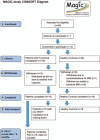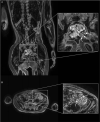Feasibility Study of a New Magnetic Resonance Imaging Mini-capsule Device to Measure Whole Gut Transit Time in Paediatric Constipation
- PMID: 33093366
- PMCID: PMC7575025
- DOI: 10.1097/MPG.0000000000002910
Feasibility Study of a New Magnetic Resonance Imaging Mini-capsule Device to Measure Whole Gut Transit Time in Paediatric Constipation
Abstract
Objective: In England, 27,500 children are referred annually to hospital with constipation. An objective measure of whole gut transit time (WGTT) could aid management. The current standard WGTT assessment, the x-ray radiopaque marker (ROM) test, gives poor definition of colonic anatomy and the radiation dose required is undesirable in children. Our objective was to develop an alternative magnetic resonance imaging (MRI) WGTT measure to the x-ray ROM test and to demonstrate its initial feasibility in paediatric constipation.
Methods: With the Nottingham Young Person's Advisory Group we developed a small (8 × 4 mm), inert polypropylene capsule shell filled with MRI-visible fat emulsion. The capsule can be imaged using MRI fat and water in-phase and out-of-phase imaging. Sixteen patients with constipation and 19 healthy participants aged 7 to 18 years old were recruited. Following a common ROM protocol, the participants swallowed 24 mini-capsules each day for 3 days and were imaged on days 4 and 7 using MRI. The number of successful studies (feasibility) and WGTT were assessed. Participants' EuroQoL Visual Analogue Scale were also collected and compared between the day before the taking the first set of mini-capsules to the day after the last MRI study day.
Results: The mini-capsules were imaged successfully in the colon of all participants. The WGTT was 78 ± 35 hours (mean ± standard deviation) for patients, and 36 ± 16 hours, P < 0.0001 for healthy controls. Carrying out the procedures did not change the EuroQoL Visual Analogue Scale scores before and after the procedures.
Conclusions: Magnetic Resonance Imaging in Paediatric Constipation was a first-in-child feasibility study of a new medical device to measure WGTT in paediatric constipation using MRI. The study showed that the new method is feasible and is well tolerated.
Conflict of interest statement
The authors report no conflicts of interest.
Figures




References
-
- Yong D, Beattie RM. Normal bowel habit and prevalence of constipation in primary school children. Ambul Child Health 1998; 4:277–282.
-
- Van den Berg MM, Benninga MA, Di Lorenzo C. Epidemiology of childhood constipation: a systematic review. Am J Gastroenterol 2006; 101:2401–2409. - PubMed
-
- Robin SG, Keller C, Zwiener R, et al. Prevalence of pediatric functional gastrointestinal disorders utilizing the Rome IV criteria. J Pediatr 2018; 195:134–139. - PubMed
-
- Scarpato E, Kolacek S, Jojkic-Pavkov D, et al. Prevalence of functional gastrointestinal disorders in children and adolescents in the Mediterranean region of Europe. Clin Gastroenterol Hepatol 2018; 16:870–876. - PubMed
Publication types
MeSH terms
Grants and funding
LinkOut - more resources
Full Text Sources
Medical

